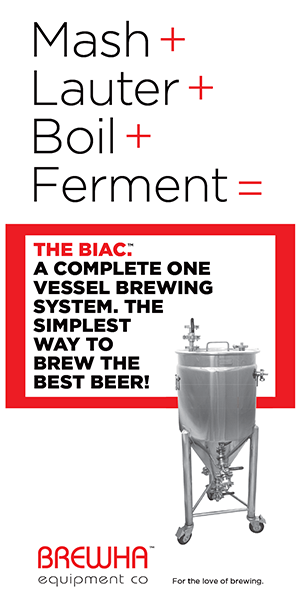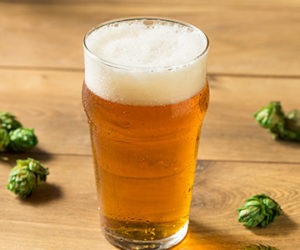Dry Hopping Techniques
Hops play a number of roles in the brewing process. Depending on when they are added, they contribute bitterness, flavor, aroma or something of all three. The bitterness comes from alpha acids contained in hops, while flavor and aroma come mostly from volatile oils. The term volatile refers to the fact that the oils boil out of the wort relatively quickly — most within 15-20 minutes. This is why brewers normally add flavor and aroma hops closer to the end of the boil. For maximum flavor and aroma, and to preserve as much of the volatile oils as possible, some brewers practice dry hopping.
What Is dry hopping?
The term dry hopping originated centuries ago with British brewers and was used to refer to adding hops to the cask shortly before it was shipped off to the customer. In fact, 1/2-ounce hop plugs were specifically developed by British hop producers to be a convenient way to add whole hops to a keg or cask. Nowadays, dry hopping refers to any hop addition after the wort has been cooled. These additions can be done in the primary fermenter, in the secondary or by adding hops directly to a keg. I have even heard of one homebrewer attempting to add one or two hop petals to each bottle of a bottle-conditioned batch! (It didn’t work though.)
Pros and cons
Due to the fact that no volatile oils are boiled off, the benefit to dry hopping is that the brewer can get as much flavor and aroma possible into the final beer. This can give your beer a floral hop essence and an intense flavor that is desirable in hoppy beer styles like pale ales and IPAs. Some commercial beers that are dry-hopped include Sierra Nevada’s Celebration Ale, Young’s Special Ale, Anchor Liberty, and Sam Adams Pale Ale.
What dry hopping does not add to the beer is bitterness. Boiling is necessary to convert the alpha acids in the hops to iso-alpha acids to create bitterness. To maintain your desired bitterness, you still need to add the bittering hops to the boil.
The lack of boiling, however, is also a potential drawback of dry hopping. That is, since they are not boiled, the hops are not sanitized. This seems to worry a lot of brewers, especially those who haven’t tried dry hopping before. The truth is that hops do not provide a supportive environment for most types of bacteria. On top of that, if the hops are added to the primary fermenter after the start of fermentation, any bacteria on them will have a difficult time competing with the vigorously active yeast in the wort. If the hops are added to the secondary fermenter then the alcohol content and the low pH of the beer will suppress bacterial growth. Keeping this in mind, it’s safe to say that bacterial contaminations caused by dry hopping are extremely rare and not worth worrying over.
The only other drawback to dry hopping is that some beer drinkers just don’t like the effect. They think it makes the beer taste “grassy” or “oily.” This method definitely gives a different kind of flavor and aroma than the traditional method of adding hops to the boil, but if you like any of the commercially dry-hopped beers mentioned, you will probably like it in your homebrew as well. Personally, I love it!
Which hops to use?
The first step in dry hopping is to select the hop variety to use. You normally want to use a hop variety that is considered a “flavor” or “aroma” hop. It is common for these hops to have relatively low alpha acid ratings, often around 6% or less. Some hop varieties commonly used for dry hopping include Cascade, Crystal, Willamette, East Kent Golding, Fuggle, Saaz, Hallertau and Tettnanger.
Of course, one of the beauties of homebrewing is that you do not have to follow anyone’s suggestions; you can try whatever you want. This being said, some homebrewers dry-hop with high alpha acid varieties like Centennial and Chinook. Personal preferences vary, and you should experiment to see what you like. In general, if you like the results of using a particular hop variety in the last 5–10 minutes of the boil then you will probably like the results of dry hopping with the same variety.
When to dry hop
Once you’ve decided what hops you’re going to use, you need to decide when to add them. The choices are in the primary fermenter, in the secondary fermenter, or in the keg.
Dry hopping in the primary fermenter will work, and is favored by some brewers, but conventional wisdom teaches that the primary might not be optimal. The problem lies in the bubbling of the CO2 and the agitation of the wort during primary fermentation. This bubbling and agitation takes some of the hop aroma out of the beer just like boiling would. This, of course, may defeat the purpose of dry hopping, although some of the hop essence will subsist. If you choose to dry-hop in the primary fermenter, you may want to add more hops than you would for dry hopping in the secondary or keg.
The secondary fermenter is generally considered the best place for dry hopping for a couple of reasons. First, the beer has already mostly fermented so, as mentioned above, the alcohol and low pH helps to ward off any bacteria on the un-sanitized hops. Second, the vigorous CO2 activity of the primary is finished, so the aroma of the hops won’t be scrubbed out of the beer.
There is, however, one potential difficulty with dry hopping in the secondary. Many brewers use glass carboys with narrow necks as their secondary fermenters. Getting the hops into, and then back out of, the slender opening can be an exercise in frustration. This is especially true if you like to keep the hops in a bag, making it easy to separate them from the beer. My recommendation is to use a bucket with a large opening rather than a carboy, or to forget about putting the hops in a bag and just dump them in. You can then separate the hops from the beer when racking to your bottling bucket or keg.
The final option for dry hopping is in the keg. Here, it is advisable to use a muslin or cheesecloth bag to contain the hops. Otherwise you run the risk of sucking hops into the system, clogging it up, or getting hops into your glass. One concern with dry hopping in the keg is the extended duration that the hops are in contact with the beer.
Some brewers feel that if the hops are in the beer for more than a few weeks, the beer develops a “grassy” flavor. Personally, I’ve never experienced it, despite leaving hops in my kegs for as long as six weeks.
Pellets, plugs or loose?
Okay, you’ve decided on the variety of hops to use and when to add them. The next question is, what form of hops to use? The choices are the same as the hops that you add to the kettle: pellets, plugs, or loose. The pros and cons are a bit different though.
As I said before, plugs were originally designed specifically for dry hopping and they work quite well for that purpose. They’re easy to measure (since each plug is a 1/2-ounce), easy to put into a bag if you choose, and are easy to fit through the neck of a carboy — even more easy if you cut them in half.
Loose hops have to be weighed, but are also easy to stuff through a carboy neck — not so easy if put in a bag though.
Pellet hops also have to be weighed, but are probably the easiest type of hops to pour through a carboy neck. They are also easy to put into a bag, but only a very fine bag will contain the powder when they dissolve.
On the other hand, pellets can cause a sudden eruption of foam that will have you scrambling for a towel and wondering what sort of alien being has taken over your beer. This is because as the pellets break apart (almost immediately) they provide thousands of nucleation sites for the CO2 in the beer to attach itself and come out of solution. Be careful and go slowly when adding pellet hops to any nearly full container.
Pellet hops will sink when well soaked. Plug and loose hops usually float. Either way it’s not too hard to rack the beer away from any form of hops if you are careful. Since pellet hops are more highly processed than plugs or loose hops, there is some concern that volatile oils are lost. When using pellets for dry hopping, you may want to add a little more than usual.
How much?
This brings us to the question of quantity. A “normal” measurement for dry hopping is between 1–2 oz. (28–56 g) of hops for a five-gallon (19-L) batch. But the real answer to the question of how much is simply, “as much as you want.” If you want just a hint of hop aroma you might go as low as a 1/2 oz. (14 g). If you want a beer that will knock you over with a pungent hop flavor and aroma, you might decide to go nuts and throw in 4 oz. (112 grams). I’ve heard of brewers using even more than this, but even a serious hophead like myself will tell you that more than four ounces of dry hops may be pushing it.
You should also take into account the variety of hop. If you’re using a hop with a high essential oil content, you probably don’t want to use as much as you might if you were using something less oily.
My advice for your first experiments with dry hopping would be to pick a traditional aroma hop and use no more than 1 ounce (28 g). This will give you a good idea of what dry hopping does for a beer. From there you are only limited by your own sense of adventure in deciding what hops to try and how much to use.
To bag or not to bag?
The final question in dry hopping is whether or not to put your hops in a bag. Bagging your hops can make them easier to retrieve when either you or your beer decides it’s time. On the other hand, hops tend to expand when wet, so a bag that you were able to stuff through the neck of a carboy dry may be difficult or impossible to get out when fully saturated.
Another issue with bagging is that it tends to reduce the hops exposure to the beer. To account for this, you may want to use 10–15% more when bagging. Also, while the hops are naturally resistant to bacteria, the bag is not. Because of this, you should always boil the bag to sanitize it before putting hops in it.
If you’re a fan of hop flavor and aroma, you really have to try dry hopping your homebrew. I’m enough of a hophead that, unless it is completely inappropriate for the style, I am dry hopping nearly all of my beers these days and enjoying every one of them.



